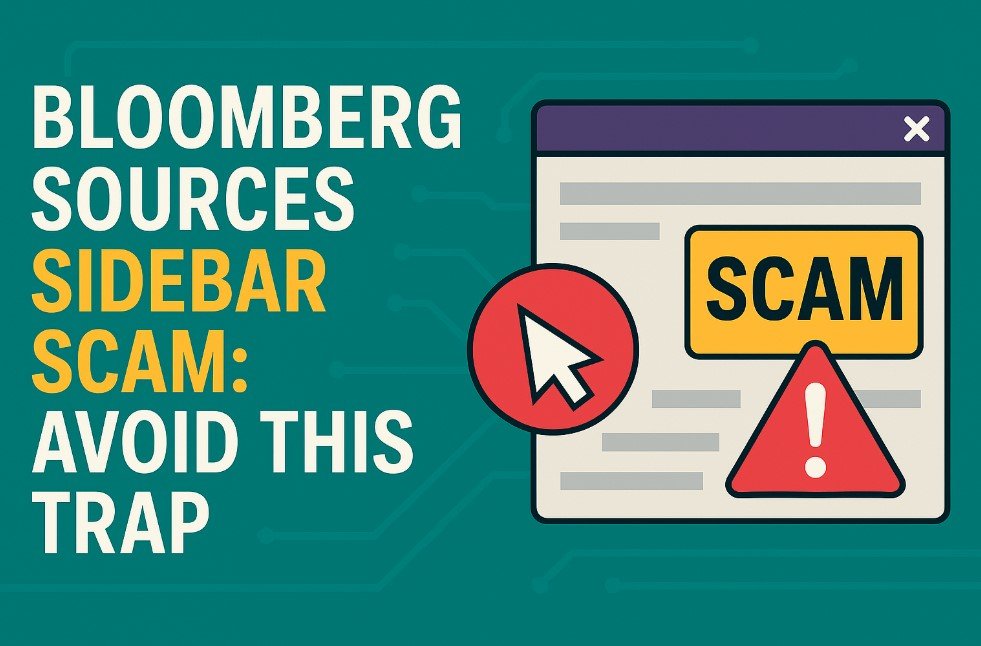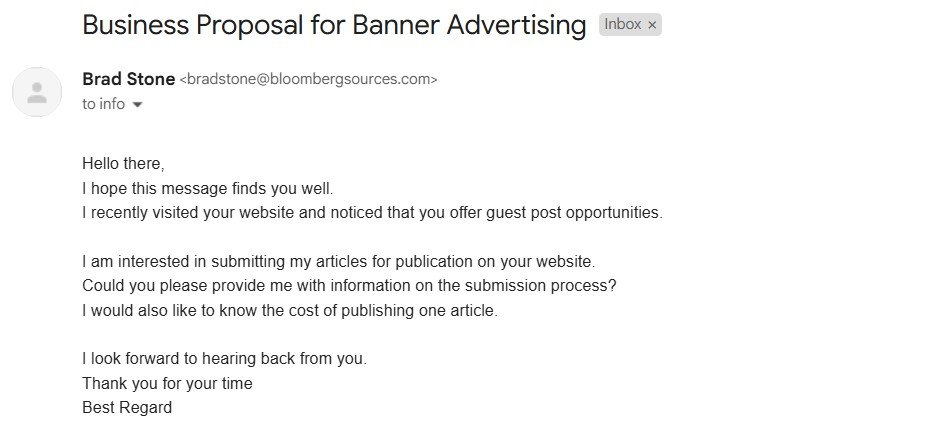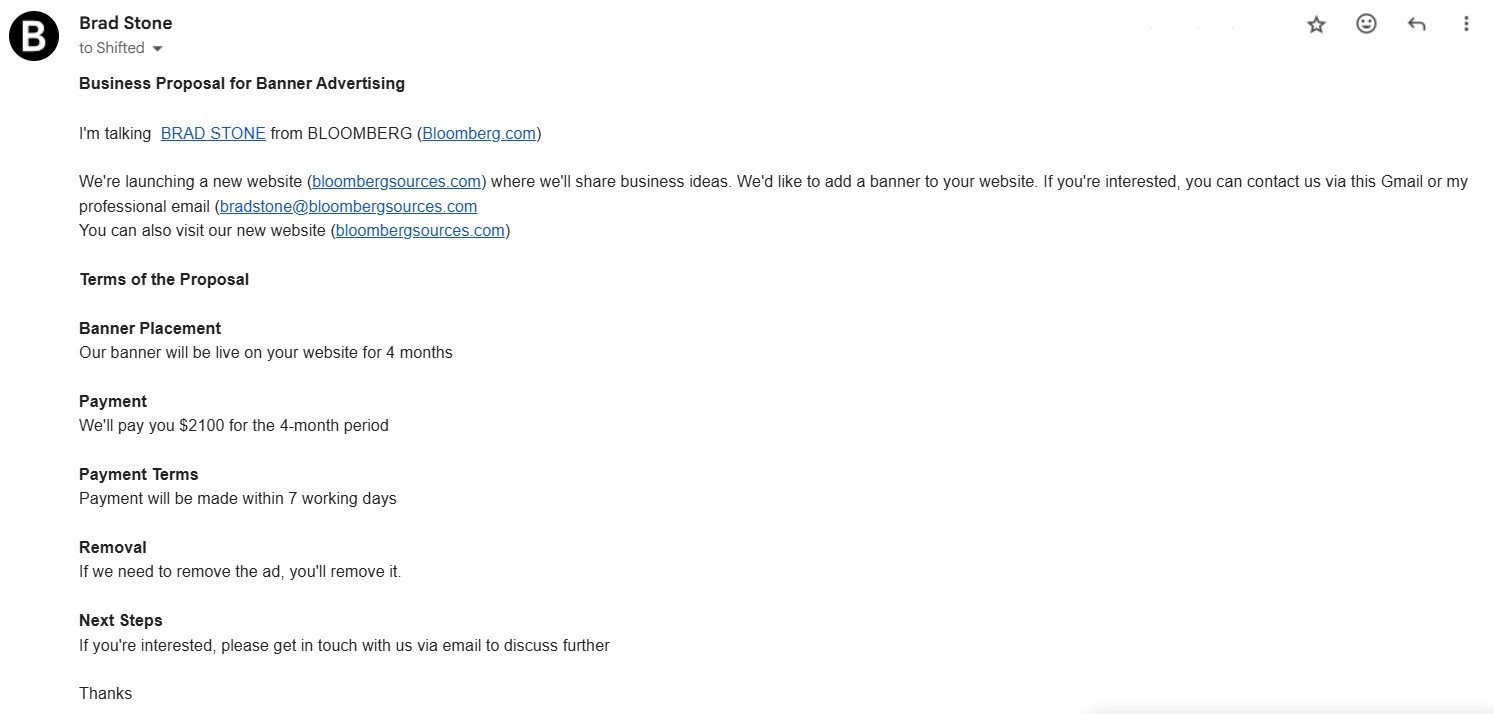Tech
Bloomberg Sources Sidebar Scam: Avoid This Trap

In the world of online publishing, bloggers and website owners often receive offers for sponsored posts, banner ads, and sidebar placements. While many of these offers are legitimate, some turn out to be scams. A new scam involving a group pretending to represent Bloomberg has recently come to light, and all website owners need to be aware of it.
This scam operates under the name Bloomberg Sources using the email address bradstone@bloombergsources.com. At first, the communication looks professional and harmless. However, what follows is a clear attempt to trick bloggers into providing free exposure without any payment.
How the Scam Starts
The scam begins when a person claiming to be Brad Stone contacts you through email. They say they have visited your website and are interested in submitting a guest post. The email is polite and sounds legitimate, asking for information about the guest posting process and the price for posting an article. This is a common and normal request, which is why many website owners respond without hesitation.
Once you reply with your rates or submission process, the scam changes direction.

The Offer: Too Good to Be True
In their second email, they no longer talk about guest posts. Instead, they offer a business proposal. They claim they are launching a new website, bloombergsources.com, which is separate from the real Bloomberg. They propose adding a banner to your website sidebar for four months. They promise to pay $2100 for this placement.
The terms they offer sound attractive:
- The banner will be live for 4 months.
- They will pay $2100 for the full period.
- Payment will be made within 7 working days after the ad goes live.
- If they request removal later, you must remove the ad.

This is where the problem begins. They ask you to add their banner or a text link immediately, assuring you that the payment will come afterward. They even provide you with a paragraph to insert into your website’s sidebar along with the link to bloombergsources.com.
The Hidden Trap
Once you place the link or banner, they claim the payment process will take up to 7 days. During this time, your website will be giving them free advertising and boosting the reputation and search rankings of bloombergsources.com.
However, no payment ever arrives. After a few days or weeks, they stop responding to emails. Attempts to follow up are ignored. Some who insist on advance payment or raise concerns receive threatening responses.
One such response reads:
“If you’re discussing advance payment, you should know that Bloomberg doesn’t deal unfairly with anyone and doesn’t scam anyone. After the ad goes live, your invoice is sent to our accounting department. The person who reviews the ad on the website then processes your invoice for payment. Once the payment is made, our department emails you to confirm if you’ve received it. If our ad is removed after that, strict action will be taken against you.”

This message is designed to intimidate website owners into leaving the ad up, even though no payment has been made.
Why They Are Doing This
The real purpose of the scam is not to promote bloombergsources.com as a genuine site. Instead, they are trying to improve the site’s visibility and SEO by getting backlinks from real, established websites. They make the site look legitimate by copying Bloomberg’s style, using real Bloomberg links on their homepage to appear credible, and by adopting professional language in their emails.
Once the fake site has enough backlinks and traffic, the scammers can use it to sell guest posts, backlinks, or ads to other third parties. They may also sell the domain itself for profit. All this is done without paying the bloggers and site owners who helped build up the site’s authority by unknowingly giving them free advertisement space.
Warning Signs
There are a few warning signs that suggest this offer is not genuine:
- They use a similar but fake domain name (bloombergsources.com) to confuse people with the real bloomberg.com.
- They promise a large sum of money but insist the ad must go live before any payment is made.
- Their payment terms are vague, relying on promises rather than clear contracts or advance deposits.
- They respond aggressively or with threats if you question their process or demand advance payment.
- They never follow up with actual payments once the ad is live.
What You Should Do
If you receive an email from bradstone@bloombergsources.com, michael@bloombergsources.com, or anyone associated with bloombergsources.com, do not engage. Do not place their banner or text link on your website. Adding the link will only benefit them while wasting your time and possibly harming your site’s reputation.
Here are a few tips to stay safe:
- Always verify who you are dealing with. Genuine brands have official emails linked to their real domains.
- Never agree to post ads or links before receiving at least partial payment or a signed contract.
- Check the domain carefully. Scammers often use domains that look similar to well-known brands.
- Be cautious of offers that sound too good to be true, especially if they promise large sums without much verification.
- If you feel uncomfortable, trust your instincts and walk away.
Similar to Mashable Footer Scam
This Bloomberg Sources Sidebar Scam operates in a very similar way to the Mashable Footer Scam we exposed earlier. In both scams, fake representatives contact website owners, offer high payouts for link placements, and use well-known brand names to appear legitimate. Just like the Mashable Footer Scam, the Bloomberg Sources Sidebar Scam relies on tricking bloggers into adding backlinks that help the scammers boost the authority of their websites without ever paying for the placement.
You can read the full details of the Mashable Footer Scam here: Mashable Footer Scam Exposed
Conclusion
The Bloomberg Sources Sidebar Scam is a clear example of how scammers target bloggers and website owners by offering high payments but delivering nothing. They use the appearance of a real brand to seem trustworthy, but their goal is only to use your website to boost their own fake projects.
Stay alert, double-check any unusual requests, and protect your website by refusing to engage with shady offers. Do not fall for the promise of easy money. In the end, it will cost you more than you realize.
-

 Tech2 months ago
Tech2 months agoSora 2 Invite Code: How to Get One (Step-by-Step Guide)
-

 Social Media2 months ago
Social Media2 months agoWhat the “67” TikTok Meme Really Means
-

 Business2 months ago
Business2 months agoDubai Freezone Company Formation: From Name Reservation to Bank Account
-

 Tech2 months ago
Tech2 months agoWhat To Do When Your Business Faces Network Vulnerabilities






